October is clearly orb weaver month, and not just here on the farm. Suddenly out of nowhere it looks as if Nature herself has decided it’s time to decorate for Halloween. There are spiders, and their webs, all over the trees, and shrubs, and every morning the woodlands seem to be draped with new webs. We won’t need any fake spider webs for decorations this year!
This week the Cross Orb Weaver (Araneus diadematus) seems to be the most prevalent species here, both in the garden, and around the house.
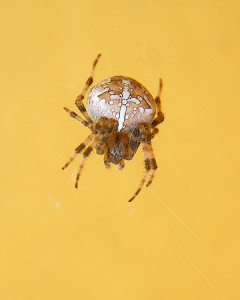
Mature female Cross Orb Weaver (Araneus diadematus). So named for the pattern of white spots on the dorsal abdomen, that resembles a cross (click any image to enlarge detail)
I’ve found many individuals of this species, in various stages of maturity, lurking in the shrubbery, or hiding underneath the patio umbrella in recent weeks.
Most mornings on the way to the garden I find myself inadvertently walking through at least one web that I didn’t see. It may sound strange, but I always feel a little bad damaging one of these webs.
I’m in awe of spiders as architects, and can’t honestly imagine the effort it must take to carefully construct a new web each morning in the hopes of catching a meal.
Araneus diadematus is not a native North American spider species. That said, it is clearly well adapted to living here, so much so that it is considered to be an invasive spider species in the Bay Area[1]. The Cross Orb Weaver is originally from Northern Europe, and became established along the Pacific Coast in the 1970s. Due to its origin, another common name for this species is the European Garden Spider.
This morning, outside the kitchen, under the patio umbrella, is this sizable, very mature, female.
I’ve been watching her for a few days now.
Each morning she crafts a web that’s almost 2 feet across, close to 5 feet if you count the bridging and tether lines that suspend the web.
She then waits for a passing meal.
I’m actually thrilled she’s there, as this morning I watched her catch breakfast, and it was a yellow-jacket wasp!
We clearly have a formidable wasp nest somewhere near the house, but I have yet to locate the entrance.
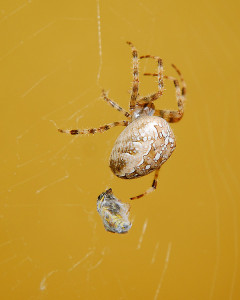
Once immobilized, and bundled in silk, this female then carried the wasp back up to the top of the umbrella
I was stung, unprovoked, on Friday morning, through two layers of clothes, which resulted in a lot of swearing, and an increased level of wariness on my part. Despite having a number of yellow jacket traps around the property, there are dozens of them buzzing around near the back door, so any help we can get to keep their populations down is appreciated!
It seems that these spiders are quite fastidious, and after watching them for the last few days, each time prey is captured, it is quickly removed from the center of the web. Perhaps this is to make the web less obvious to other insects flying by?
Just as I was getting ready to leave, I noticed an immature female on the other side of the patio umbrella. No sooner had I spied her, than another yellow jacket met its doom!
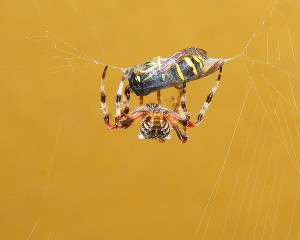
This immature orbweaver, not much larger than the yellow jacket, had no difficulty dispatching its prey.
Even if you’re scared of spiders you can see that they are hard-working, beneficial creatures in the garden, preying on pests, so please leave them be, and don’t squish them.
Moving beyond the patio, I recently bumped into a male and female pair in the herb garden, consisting of an immature female, and a mature male. Side by side it’s obvious that the males and females of this species are a different shape. Mature females are more rounded in appearance, and grow to 20 mm in length, almost twice the size of the smaller males.
The female had successfully captured a honey bee, and cocooned it in silk. Lurking just below her in the oregano was a male.
The markings weren’t as prominent on this female, and she was more equal in size to the male. If this was a mature female, she’d dwarf him in size.
Late summer to early autumn is breeding season for these spiders. I wondered if the male was perhaps a potential mate, so I waited to see what transpired.
Courtship for male orbweaving spiders is a dangerous game. One misstep, and the male will meet the same fate as the bee.
The male would approach cautiously, and when just barely within reach, he’d touch her. She’d immediately raise her legs and dart toward him, which sent him scurrying in retreat.
After a while it became apparent that perhaps this male was less interested in her, and more interested in her prize.
Eventually the female retreated underneath an oregano branch, leaving her prey unguarded. The male then slowly approached the bee.
However, as soon as he was within reach, he knocked it loose, and the bee fell down into the dirt below. I could almost hear the female cursing at this male for being such a klutz!
With the bee gone, after a few minutes the male continued his approach toward the female.
There was a lot of leg-waving, cautious approaches, and hurried retreats, but mostly the female seemed to ignore the male’s advances.
It was already early evening, and the light was fading, so I chose to wait and check in on them again in the morning.
The next morning though, both spiders were gone. Perhaps the female constructed her web elsewhere in the garden that morning, or perhaps they both became prey for a hungry bird. Regardless, that was the last I saw of this pair. This immature female likely wouldn’t reproduce this season, and as a juvenile, she may overwinter in the garden, to breed next season.
Between now and November the mature females that survive, and mate, will begin to construct their egg sacs. They will then stay with their eggs to guard them, but will cease foraging, until eventually they die in the late autumn to early winter.
Earlier this spring I’d found some recently hatched orb weaver spiderlings, and at the time I had presumed they were most likely Araneus diadematus species. As the females that produce the egg sacs don’t survive winter though, I wasn’t able to find any of this species in the spring. This autumn though, it’s obvious we have a healthy population of them on the farm. Now that I’ve noticed so many females here this fall, I suspect the spiderlings were indeed Cross Orb Weavers, and maybe we’ll find more spiderlings hatching here next spring.
There’s no question we’ll have more yellow jackets next season!
—————-
[1] KQED Quest: Spider Invaders by by Jennifer Skene Oct. 2010

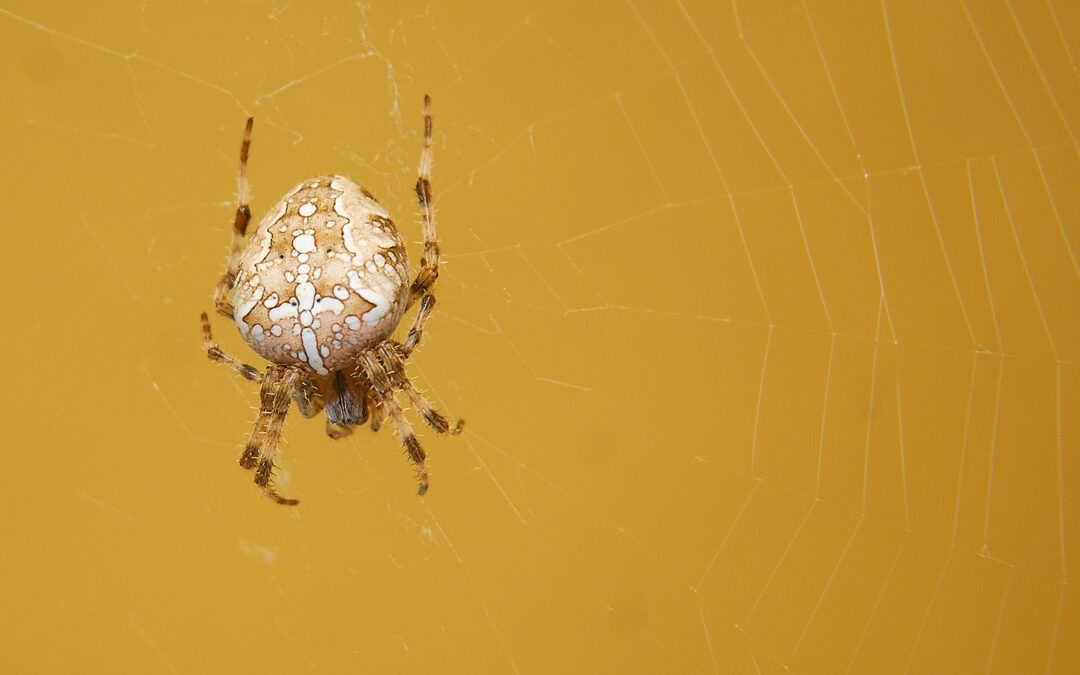



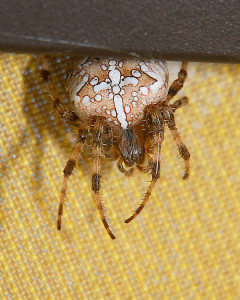
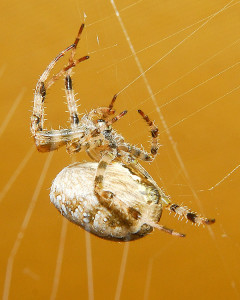
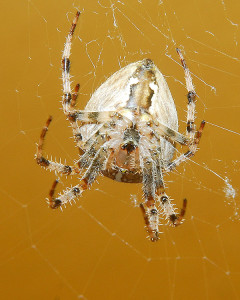

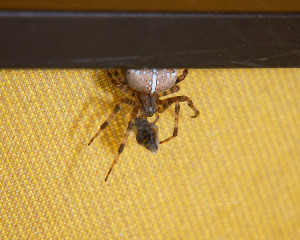
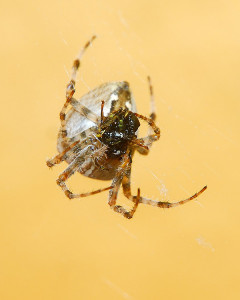
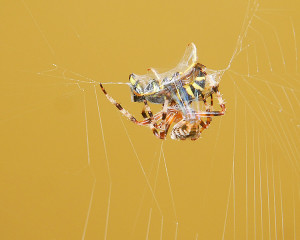

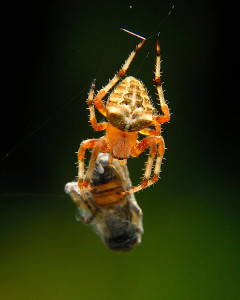
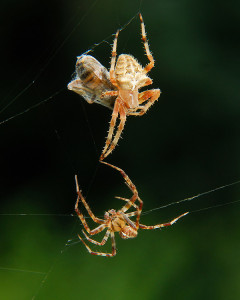
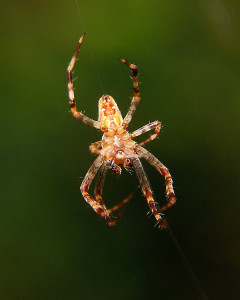

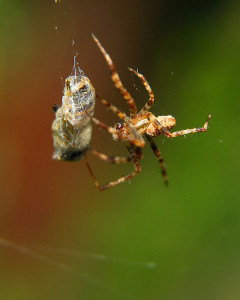
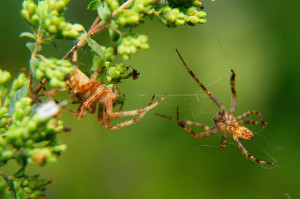

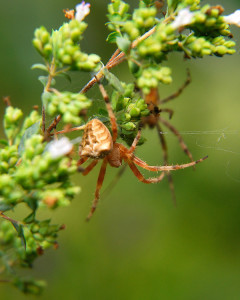
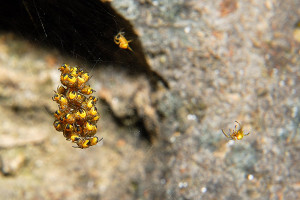
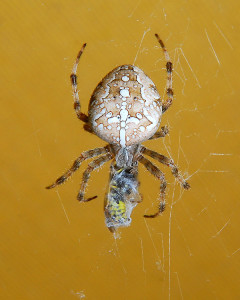







Clare,
Enjoyed this posting, these are much like our orbweaver spiders hanging from our eaves. The ones we have are of mixed breeding and hard to tell what they are, we just call them Barn Orbweavers. We also have the stunning Marbled Orbweaver which I have not seen yet.
Really enjoyed the awesome photos!
We have quite a few different orb-weavers here too, although, honestly, I haven’t spent much time trying to ID them yet. This one was easy, as the cross on the back is pretty diagnostic 😉
I love autumn for the orb weavers: huge bodies and giant webs!
Your photos are *fantastic*. Just beautiful! I did not know that this was mating season and that the eggs overwintered, but I guess it makes sense. There is one spot in my garden that has had an orb weaver web in it every year — I need to check it now to see if it’s back again. I presume one of the spiderlings wins out over all of the rest?
The only thing bad about orb weaver webs is they can really disrupt an early morning garden stroll. Web in the face!
I don’t know if the spiderlings are competitive per se. When I looked into them earlier this year I was under the impression that they simply disperse. Some baby spiders can even disperse from their natal sites on strings of silk, and be carried by the wind. I’m sure quite a few are lost to predators though. Regardless, the population of these Cross Orb Weavers seems be quite robust here!
I’m going to have to take a closer look at the webs around our house now. We have what feels like hundreds of spiders blocking every part of both porches and I have a feeling they may be the same ones you have. Great close up shots of these little guys and their activities.
I bet you have these, probably among others. This is certainly one of the most common species in most gardens. If you see the cross, you know you have this species, although some of the immature females can be less obvious in their markings.
Really nice photos, I especially like those of the webs. Very timely for this time of year too.
Spider webs really fascinate me. One of things I love this time of year is when we get a cool and foggy morning, and all of the webs in the trees are draped in dew. 🙂
It’s funny you should mention that you feel guilty about breaking a spiders web, but I feel the same way. It does seem like so much work to build a spiderweb. And of course I am interested in having them catch all the mosquitoes that they can at my house.
Glad I’m not the only one, I always feel bad when I go bungling through a large web. I know this is what spiders do, but I do appreciate how much effort it must be to construct a new one every day, without some blundering human destroying it. 😛
Amazing photographs of a beautiful creature!
Thanks Denise, I had a very patient subject 🙂
They really are amazing creatures aren’t they? The ones we have look a bit different, but their behaviour sounds just the same, except that they spin their web at night and as soon as it’s light they dismantle it and hide during the day, so it’s difficult to get good photos – your’s are great! Our orb weavers don’t usually show up until the weather gets quite warm, so usually around December I think. I wrote about our last visitor here in case you want to read about an “Aussie-Orb”!
http://citygardencountrygarden.blogspot.com.au/2012/01/city-garden-summer-visitor.html
Goodness, your orb weaver sounds like she makes a huge web! They do seem to like warm weather. Here we notice them the most in the early Autumn, before the first rains.
This is so cool! I find spiders absolutely fascinating! Your photos are amazing! Thanks for sharing your little Charlotte with us!
I quite like the name Charlotte, even though she hasn’t written anything in her web…yet 😉
Beautiful spiders! What a lot of patience you have, and those photos are well worth the effort. We’re plagued with yellow jackets here too, but I saw something this year that made me think differently about them. There were several tomato worms in the garden this year. I watched the yellow jackets attack and kill them all. It was pretty gruesome, but nice to know that even the most horrible creatures have their good side.
It’s good to know the yellow jackets have a good side. Here, when they’re not stinging me, they seem to delight in trying to gain access to our bee hives, where they go to the brood nest, and steal the baby bees out of the hive 🙁 Maybe if I had hornworms here, I wouldn’t dislike the wasps so much!
The situation Alan describes happened to me just yesterday. (Web in the face.) Spiders are fascinating and creepy. But their webs are oh, so beautiful!
I’ve had a few webs in the face, or tangled in my hair, this season. Not the most pleasant start to the morning, but I mostly feel bad that I destroyed all their hard work!
Clare I am also fascinated by spiders in the garden…I am still learning about all the different ones that live there and they are busy this fall with many webs. They are truly works of art. I hope to learn more about the spiders who live here.
I don’t yet know many of the species of spider here. A few of them I’m familiar with, including the Argiope species I wrote about last fall, and the jumping spiders that like to wave from the flowers to scare away predators (aka gardeners) 😉
Great captures! The webs that they build are so pretty!
We were at an aquarium this morning, and they had an exhibit with some sort of very large orb weaver spider in it. The sign said that the web threads were stronger than steel! That’s impressive. Though I guess you need strong thread to catch stuff like yellow jackets!
I was really impressed watching them catch the yellow jackets. The wasps simply didn’t stand a chance. For their size, these spiders move incredibly fast, pouncing on the wasp that just was snagged in the silks, and before the wasp knows what hit it, it’s been encased in more silk. All in just a couple of seconds. Wish I’d captured video, it’s quite a sight!
What a fascinating post! You did a wonderful job capturing images of the Cross Orb. I have always had a friendly attitude toward spiders, as long as they were in the garden and not in my house! Like you, I always feel a little guilty when I walk through a spider web. There are lots of them around here, too, and I truly admire the workmanship.
The female under the umbrella really did have exquisite markings. Some of the spiders I’ve seen this fall haven’t had as prominent a cross on their abdomens. With all the bad bugs around here, it’s comforting to know we have a number of good bugs helping to maintain some balance!